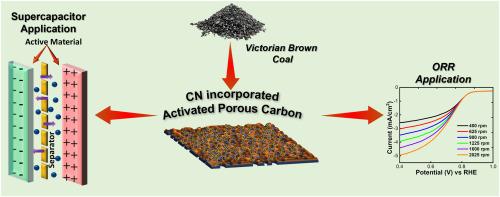从维多利亚褐煤中提取的纳米多孔碳纳米结构用于超级电容器和氧还原反应
IF 11.6
2区 材料科学
Q1 CHEMISTRY, PHYSICAL
引用次数: 0
摘要
纳米多孔碳具有高比表面积、大孔体积和可调孔隙率等特点,是一种非常有前途的能量储存和转化材料。在此,我们报道了氮化碳(CN)通过KOH固态活化和氨基胍在惰性条件下低温碳化的方法,将纳米孔碳从大量可用的低成本维多利亚褐煤中分离出来。制备的材料具有高比表面积(>3100 m2 g-1),大孔体积(>1.7 cm3 g-1)和分层纳米孔结构。在0.5 a g−1的电流密度下,优化后的材料具有226.5 F g-1的高比电容。该对称超级电容器器件在582 Wkg-1功率密度下的能量密度为18 Wh kg-1。此外,准固体KOH/PVA凝胶基超级电容器在0.1 a g-1下的比电容为119.3 F -1。AG10材料在氧还原反应中表现出优异的极限电流密度,在0.2 V时达到5.31 mA cm−2,显著高于不含CN的纳米多孔碳(0.94 mA cm−2)。纳米多孔碳在离子转移和提供电导率方面起着关键作用,而CN则有利于提供丰富的电化学活性位点,从而提高电容和催化性能。这项工作证明了CN的最佳掺入在赋予N功能的同时保持高表面积和孔隙度的优势,以改善能量储存和氧还原反应性能。本文章由计算机程序翻译,如有差异,请以英文原文为准。

Carbon nitride incorporated nanoporous carbon nanoarchitectonics derived from Victorian brown coal for supercapacitor and oxygen reduction reaction
Nanoporous carbon is a highly promising material for energy storage and conversion due to its high specific surface area, large pore volume, and tunable porosity. Herein, we report carbon nitride (CN) incorporated nanoporous carbon derived from largely available and low-cost Victorian brown coal through the KOH solid-state activation followed by the carbonization of aminoguanidine at low temperatures under inert conditions. The prepared materials have high specific surface areas (>3100 m2 g-1), large pore volumes (>1.7 cm3 g-1), and a hierarchical nanoporous structure. At a current density of 0.5 A g−1, the optimized material exhibited a high specific capacitance of 226.5 F g-1. The symmetric supercapacitor device demonstrated an energy density of 18 Wh kg−1 at a power density of 582 Wkg-1. Furthermore, a quasi-solid KOH/PVA gel-based supercapacitor exhibited a specific capacitance of 119.3 F g-1 at 0.1 A g-1. The AG10 material also demonstrated an excellent limiting current density of 5.31 mA cm−2 at 0.2 V in the oxygen reduction reaction, significantly higher than the nanoporous carbon without CN (0.94 mA cm−2). While the nanoporous carbon plays a key role in ion transfer and providing electrical conductivity, CN is beneficial for providing abundant electrochemical active sites for improving capacitive and catalytic performance. The work demonstrates the advantage of optimal incorporation of CN in imparting N functionalities while retaining high surface area and porosity for improved energy storage and oxygen reduction reaction performance.
求助全文
通过发布文献求助,成功后即可免费获取论文全文。
去求助
来源期刊

Carbon
工程技术-材料科学:综合
CiteScore
20.80
自引率
7.30%
发文量
0
审稿时长
23 days
期刊介绍:
The journal Carbon is an international multidisciplinary forum for communicating scientific advances in the field of carbon materials. It reports new findings related to the formation, structure, properties, behaviors, and technological applications of carbons. Carbons are a broad class of ordered or disordered solid phases composed primarily of elemental carbon, including but not limited to carbon black, carbon fibers and filaments, carbon nanotubes, diamond and diamond-like carbon, fullerenes, glassy carbon, graphite, graphene, graphene-oxide, porous carbons, pyrolytic carbon, and other sp2 and non-sp2 hybridized carbon systems. Carbon is the companion title to the open access journal Carbon Trends. Relevant application areas for carbon materials include biology and medicine, catalysis, electronic, optoelectronic, spintronic, high-frequency, and photonic devices, energy storage and conversion systems, environmental applications and water treatment, smart materials and systems, and structural and thermal applications.
 求助内容:
求助内容: 应助结果提醒方式:
应助结果提醒方式:


